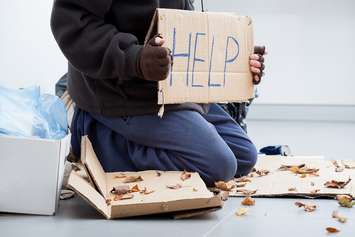As Canada prepares to mark the UN International Day for the Eradication of Poverty on Friday, October 17, community leaders in Grey and Bruce Counties are warning that poverty, inequality, and housing insecurity are deepening across the region — mirroring a growing national crisis.
The Coordinator of the Bruce Grey Poverty Task Force, Jill Umbach, revealed that more families and individuals are struggling to afford basic necessities, with local food banks and shelters reporting record demand.
"Households that don't have enough income to purchase food, don't have enough income to cover all the rent," she added. "Here at the United Way, there are many people who are going into arrears with their utilities because rent is so high, or they're having challenges to pay everything associated with owning a home. So we know that people are struggling."
She pointed out that since the pandemic, poverty has increased sharply across every demographic group, with 1.4 million children — one in five — now living in poverty across Canada. Across the region, one in four people faced food insecurity last year.
"Poverty is not abstract, it’s something we see and respond to daily here in Grey and Bruce,” said Umbach. “We’re witnessing more families struggling to put food on the table, more people living without stable housing, and greater pressure on the local services trying to support them.”
Umbach pointed out the local living wage sits at $23.05 an hour, which is the second highest in Ontario, next to Toronto, while local wages are among the lowest in the province.
"But we know that a lot of people who are working aren't getting that much. They're working for a minimum wage. We have seen an increase. The Ontario government this year just announced an increase from $17.20 to $17.60 for the minimum wage, but it's still falling less than a living wage, and a living wage is just what people need to survive on," Umbach stressed. "And then between men and women, we know that there's an inequity. So in Grey-Bruce, the median after-tax income for men is $42,000, and for women, it's $32,000, and that's below the poverty line for the women."
In fact, men earn 31.3 per cent more than women in Grey-Bruce.
“We are seeing more people working full-time and still not able to make ends meet,” said Francesca Dobbyn, Executive Director of United Way Bruce Grey. “Rising costs for rent, food, and utilities are pushing many residents to the brink. We need to invest in solutions that address not just emergency needs, but the root causes of poverty — from affordable housing to income security.”
The Bruce Grey Poverty Task Force is urging governments to strengthen income supports such as the Canada Child Benefit and Canada Workers Benefit, raise the Canada Disability Benefit above the poverty line, and invest in deeply affordable housing, eviction prevention, and universal childcare.
"And we know with the example of the CERB during the pandemic, that works incredibly well to keep people afloat," Umbach noted. "So we know that income solutions are the way to go with food insecurity. And we know that there are other ways that we can look at in terms of rent. Right now, we don't have rent control on anything built after 2018."
Nationally, the number of people experiencing homelessness has nearly doubled since 2018, and one in four Canadians experienced food insecurity in 2024. The income gap between the richest and poorest has reached record highs.
Umbach said a lack of affordable housing is a big part of the problem, especially for those with very low incomes.
"We need deeply affordable housing, that is supportive housing as well. So we know that right now, there's a lot of money coming from the federal government and the province to do more builds in partnership with our counties and municipalities," she continued. "But we don't necessarily have the support for people with mental health issues."
The United Way Bruce Grey and the Bruce Grey Poverty Task Force will join 42 other organization on a Webinar on Friday seeking solutions to a growing poverty crisis. A Future Without Poverty National Dialogue Webinar takes place Fon riday between 12 and 2 p.m.
“We need renewed leadership and investment from all levels of government,” said Umbach, “to ensure basic human rights: adequate food, housing, income, and care.”
"We're really asking the federal government to take a look at what's the future going forward," Umbach continued. "What are the targets that the national government has for reducing child poverty? Because we certainly didn't meet the original target, that by the year 2000 we would eradicate child poverty in Canada."
The National Advisory Council on Poverty has warned that Canada is unlikely to meet its goal of cutting poverty in half by 2030 without immediate, coordinated action.
Alexis Cook, Coordinator of the Grey Bruce Community Safety and Wellbeing Plan, said reducing poverty is essential to community safety and resilience.
“When people’s basic needs aren’t met, their ability to stay healthy, safe, and connected to their community is compromised,” she said.
The Bruce Grey Poverty Task Force works collaboratively across both counties to reduce poverty and improve well-being through partnerships with social services, local governments, and residents with lived experience.






